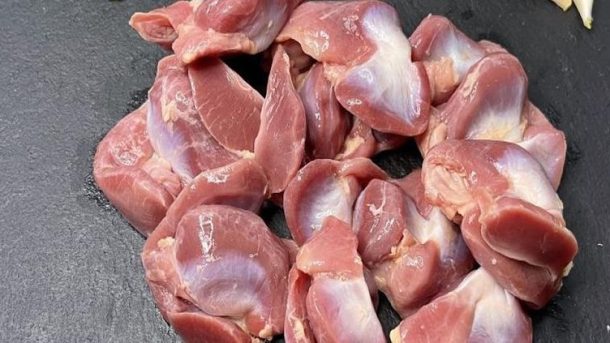Although some of us might turn our noses up at the thought of eating them, chicken gizzards are a common ingredient in cuisines all across the globe. In Haiti and Southeast Asia, they are often grilled and sold as street food, while in Mexico they’re a popular ingredient in soup. In Africa, you can find them cooked a number of different ways, such as fried, boiled, or grilled. And in Europe, they’re commonly served overtop salads or in pates.
However, chicken gizzards provide many nutrients, are easy to prepare, and are very affordable. Here, we’ll explain why you should include them in your diet.
The gizzard is the muscular stomach that birds, especially grain-eating ones, have. Many people consider it offal and tend not to cook it because of its appearance.
But if you live in the states, you’re likely most familiar with the deep-fried gizzards that are particularly popular in the South (as pictured above). No matter your preconceived notions of gizzards, these little meat morsels have more to offer than you might think. Learn everything you need to know about gizzards, including how to buy, cook, and store them.
What Are Chicken Gizzards?
Have you ever asked yourself, “how do chickens eat without teeth?” No? Just me? Well, it’s a perplexing question, and the answer lies with the gizzard.
Chickens take in food with their beaks, by pecking feed, grains, insects, and other morsels into their mouths. This food then travels down the esophagus, with the help of a little saliva and digestive enzymes. From here it makes its way to the crop, which is basically a storage compartment at the base of the esophagus where food can be stored for up to 12 hours. Finally, the food trickles from the crop down to the gizzard, where the food is physically ground up. Refer to the illustration above to see where the gizzard is located within the digestive tract.
So there you have it — a chicken gizzard is basically the stomach of the chicken. It’s made of muscular walls that contract. The gizzard is aided by gritty, sand-like particles the chickens ingest as they peck that help to grind the food so that it may pass to the small intestine, where nutrients are absorbed. So, why don’t chickens have teeth? They don’t need them! The gizzard does all the work.
Chickens aren’t the only animals with gizzards. They can be found in the digestive tracts of many animals, including crocodiles, alligators, birds, earthworms, some fish, and some crustaceans.
Because they are a muscle, gizzards tend to be quite chewy and taste like dark-meat chicken. Despite their small size, gizzards are packed with protein, and low in fat, making them one of the healthiest parts of the chicken.
Gizzards vs. Giblets
Gizzards are always giblets. But giblets are not always gizzards. Okay, enough riddles. The term giblets simply refers to a group of miscellaneous chicken parts, including the gizzard, the heart, the kidneys, the neck, and the liver.
How to Prep and Cook Chicken Gizzards
If your gizzards haven’t already been cleaned, that’s your first step. Start by cutting the gizzard in half lengthwise. Now you can wash the sediment away using your fingers and running water. Once the gizzard is clean, peel away the yellow-tinted lining. Now you’re ready to get cooking!
In general, gizzards do best when cooked low and slow, with moist heat. Because they are already a dense and chewy muscle, cooking them on high heat will only cause them to toughen up even more. This Chicken Gizzards recipe simmers the gizzards for over an hour so you get the most tender result.
In the American South, you’ll often find gizzards served fried. Give this top-rated Southern Fried Chicken Gizzards recipe a try next time you want tender, breaded gizzards.
How to Store Chicken Gizzards
Raw gizzards should be the first thing to go in your fridge when you get home from the supermarket. Keep them sealed in an airtight container or plastic bag to prevent cross-contamination. Use within two days, or freeze in an airtight container for up to four months.



